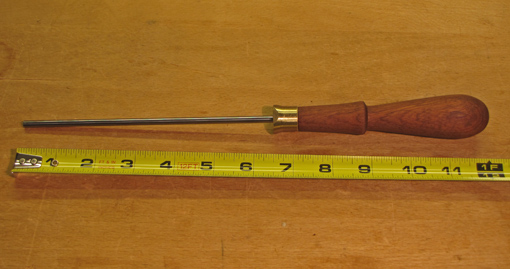
A Google search will yield many references to carbide burnishing tools used to form the hook on a scraper. I first came across the use of carbide in a commercially made burnisher in the old wooden-body version of Veritas’ Variable Burnisher which houses a short carbide rod. (The body of the current version is a molded man-made material.) I later purchased their Burnisher which has a 1/8″ carbide rod projecting 3/4″ from a simple handle. Despite its small size, I found myself using this tool in preference to all of the many (too many) steel burnishers I’ve bought or made over the years. I just needed more length.
Pictured above is my homemade Burnisher for Life. Three and one-half years ago I asked the folks at Innovative Carbide to make a 3/16″ diameter 12″ highly polished carbide rod. I explained the intended use and they recommended an appropriate grade of carbide (10S) with excellent wear resistance. It cost about $50. I drilled a hole in a $4 handle to house 5 ½” of the rod with a press fit, which thus is effectively stored for future use, though I doubt it will be needed any time soon.
This is by far, no contest, the best burnisher I’ve ever used. The very hard and smooth carbide gives effortless, controlled burnishing. The length, though more than necessary, allows a combination of forward and sideways motions creating smooth action against the steel.
There are a few other homemade carbide burnishers to be found on the internet, but currently there is no need to make your own. Lie-Nielsen and Blue Spruce make carbide burnishers that look excellent, as expected from these makers, though I have not used them. The Blue Spruce is listed as 1/4″ in diameter and the Lie-Nielsen appears to be similar. I like the pressure produced by the 3/16″ diameter but I’m sure 1/4″ would work well and, I suppose, be sturdier.
A full size carbide burnisher, store bought or homemade, is relatively expensive but I’ll bet once you try one, it will be the only kind you’ll want to use.


What do you think about the Hock Tools burnishers? They say theirs are hardened (Rc64) and polished tool-steel rods that stand up well to constant use on scraper edges. At $15 (sans handle) this seems like the best deal.
Hi Wesley,
I haven’t used it but I know Hock makes great stuff and it is inexpensive. If you want to go deluxe, give carbide a try. The 10s carbide is much harder, Rc 78-80 (Ra 91-92).
Rob
Hi Rob
I have to agree with you, but all this begs the question: What are the hardness values of the Lie-Nielsen and Blue Spruce carbide burnishers? Their web sites don’t give this information. And since the folks at Innovative Carbide are not selling these rods other than by special order, what would be be best way to go? I guess the Blue Spruce, it’s the prettiest.
Wesley
Almost all grades of carbide are much harder and more wear resistant than tool steel. Ask them, but I certainly would trust either of those excellent tool makers to have chosen an appropriate carbide.
Happy scraping!
Rob
Hi Rob,
For years I have used the Veritas Variable Burnisher. Have you used it? I have been very satisfied with how it creates a consistent burr on the edges of scrapers. The hardness of the steel I couldn’t tell you, and I wonder how important it is. I usually have it set at five degrees, and as long as the edge of the scraper has been prepared well, in three passes, with just slight downward pressure, I get the right burr. Depending on the number of passes and the pressure, it can be lighter or heavier, but what I like is that it is very even over the length of the blade.
Best,
Tico
I used the original wood-bodied version which, like the current version, uses a carbide rod. It worked well for me and, I agree, it produces a consistent burr along the entire edge.
I like a simple handled-rod burnisher which can also be used to “consolidate” the edge prior to forming the hook, can form the burr with the compound stroke that I described in the post, and can form the hook with progressively more angled passes which I think gives a sturdier hook.
It’s just personal preference really. There are many good ways to do all of this like just about everything else in woodworking.
Rob
I have LV varable burnisher. Unfortunately, its carbide rod was not polished, just ground. It was leaving tracks on the burr. It took quite an effort to polish it somehow.
With steel burnishers, I don’t have much luck with modern hard scrapers. Those scrapers even dull Nicholson file at once. The file that LV supplied in the kit, though, works.
Alexandre,
Thanks for the comment. I guess you used a diamond abrasive to polish the carbide but it still must have been difficult.
Rob